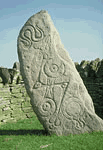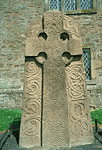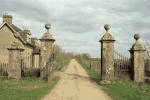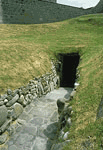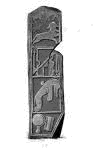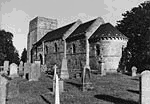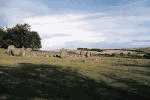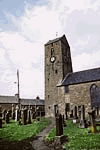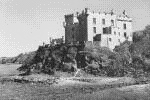|
|
|
|
|
Travel Mysterious Scotland
Aberfoyle, Central
(Fairy Hill near Aberfoyle Graveyard)
Robert Kirk the author of The Secret Commonwealth a book on fairy lore is buried in Aberfoyle graveyard. Nearby is Dun-shi hill the Fairy Hill where he is said to have died. According to local legends he ran 7 times around the top of the hill trying to summon the Devil and died on the 7th circuit. Others say that he did not die but was made a prisoner of the fairies.
Aberlemno, Tayside
Three Pictish stones stand by the roadside in Aberlemno and in the graveyard of the church is the Aberlemno Stone on which dragons and monstrous beasts are depicted.
Abernethy, Tayside
Dr John Brown the Abernethy author of the Dictionary of the Holy Bible is with some irony reputed to have been charged with witchcraft due to his neighbours' suspicions that he had been given his learning by the Devil!
Auchencrow, Borders
Usually Witch Stones are large boulders said to mark the places where witches were burned. Auchencrow is home to a number of them but according to local legend these were dropped by witches on the way to their sabbats.
Auldearn, Highlands (Witchcraft)
The Scottish witch Isobel Goudie claimed to have been baptised by the Devil in Auldearn Church graveyard. A number of other witches at Auldearn were brought to trial and confessed to riding on broomsticks, making children ill, raising storms, plaguing cattle, etc. The church is now a ruin but can still be seen east of the 19th century church.
Brahan, Highlands (Witchcraft)
Around 1650, after being convicted of witchcraft, the 'Brahan Seer' Cinneach Odhar made a number of unfavourable prophesies about the Seaforth family of Brahan Castle. In Brahan Wood there is supposed to be a rock called Gradhthol with a hole in it through which sick children would be passed to cure them of their ailments. The stone no longer exists and it may be a confusion with a holed stone that Odhar used for divination. When he was approaching his death Odhar is said to have thrown the stone into a cows hoof print which then expanded into the hoof-shaped Loch Ussie.
Brodgar, Orkney (Stone Circle)
Orkney has one of Britain's best stone circles. The Ring of Brodgar stone circle is over 100 metres in diameter and although only 27 of the original 60 equally spaced stones are still standing many of the fallen stones are close to their original positions. At least one of the stones contains an indecipherable runic inscription.
Burghead, Grampian (Holy Well)
A grave slab with a hollowed surface called the Cradle Stone is built into the wall of the old graveyard at the top of Burghead. According to legend if you strike the stone in the hollow, the sound of a baby crying and a cradle rocking will be heard. Burghead also contains an ancient holy well within the bailey of Burghead fort (Bailey's Well) a chamber cut into rock with steps leading down to it. On the 11th January (the date of the old Scottish New Year) Burghead annually holds a unique festival of fire known as the Burning of the Clavie an ancient tradition faithfully kept up by the villagers.
Cairngorms, Highlands (Legend, Haunting)
An evil and ugly monster known as the famh (gaelic for mole) is said to haunt the Glen Avin area of the mountains of the Cairngorms. It is said to have a head twice the size of its body and anyone crossing its tracks before the sun rises will quickly die. Another figure haunting the Cairngorms is the Fear Liath Mor (gaelic for Great Grey Man) of Ben Macdhui, a ghostly human spectre.
Callanish, Isle of Lewis (Stone Circle)
The best of Scotland's stone circles is the stone circle of Callanish. Callanish has a central circle of 13 stones, the tallest being almost 4 metres tall. Leading to the stone circle is an avenue of monoliths. Callanish was almost certainly used for astronomical purposes. The skimming of the moon at Callanish which takes place every 18.5 years is still impressive.When viewed from the north, the moon rises in the east, skims along the avenue of stones and eventually sets in the horizon in the middle of the circle leaving a number of strange afterglow effects on the stones. 2 other stone circles are close by but these are dwarfed into insignificance by callanish's majesty.
Chapel of Garioch, Grampian
A small stone circle known as Balquhain lies close to the village of Chapel of Garioch and about half a mile from the village is a 3.5 metre inscribed Pictish Cross known as the Maiden Stone.
Crieff, Tayside (Witchcraft)
According to legend, a witch called Catherine Niven was strangled and burned on cnoic (gaelic for hill)or Knock Hill near Crieff. As she was being dragged up the hill she spat out a blue stone and gave it to one of her foster children as a good luck charm which was later set into a ring and kept as a treasure by the family. As Nicniven was the secret name of the Fairy Queen, the legend is probably spurious.
Crook of Alves, Grampian (Macbeth)
The south slope of the Knock or cnoic (gaelic for hill) at Crook of Alves is reputed to be the place where Macbeth met the 3 witches in Shakespeare's famous Scottish play 'Macbeth'.
Culross, Fife (Witchcraft)
According to legend the witch Helen Eliot was due to be burned at the stake at Culross when the Devil came and carried her off into the air. Eliot swore in surprise using the name of God and the Devil dropped her which made her 'brake her leggs'. She was then carried on a chair to be strangled and burned.
Dalkeith, Lothian (Witchcraft)
Dalkeith was a centre of the witchcraft scares in the 1600s and at least 11 people were strangled and burned for witchcraft in 1661 in Dalkeith. In 1638, James Spalding a Dalkeith man was hanged for murder but prayed not to be allowed to die until he was reconciled with God. Failing to die on the scaffold, he was buried alive resulting in 'such a rumbling and tumbling in his grave that the very earth was raised'. Spalding's house is reputed still to be haunted.
Dalmeny, Lothian (Astrology)
The Norman carvings on the St Cuthbert's Church are usually described as astrological figures but the only design which can be definitely be discerned is a medieval Sagittarius symbol, though this may be meant to show a centaur.
Daviot, Grampian (Stone Circle)
The Loanhead Stone Circle is one of the best in Scotland. It consists of a 'recumbant' stone circle with a further smaller circle outside it.
Doon Hill, Lothian (Witchcraft)
Local legend sites the prehistoric fort remains as the site of a number of executions of witches. The pile of stones that lies north of the fort is said to represent the number of witches burnt.
Dornoch, Highlands (Green Man, Witchcraft)
Dornoch cathedral, one of the oldest churches in Scotland has a number of gargoyles on the outside of the church and a Green Man. This is often confused with the Dornach imp which is not part of the fabric of the church but now resides in the wall of a private residence. Janet Horn was the last person to be officially executed for witchcraft in Scotland. she was burned in Dornach in 1727.
Dronley, Tayside (Dragon)
St Martin's stone, a large boulder just outside Dronley marks the spot where a man-eating dragon was killed. The pictish carving on the rock shows a man on horseback attacking a serpent with a spear.
Dumbarton, Strathclyde (Devil)
The rocks comprising Dumbarton Rock are said to have been thrown there by the Devil (or all Scotland's witches depending on the version of the legend) who drove St Patrick to Ireland. The ancient name for Dumbarton rock was Dunbreatan (meaning fort of the Britons) from which the name Dumbarton was derived.
Dunbar, Lothian (Sphinx)
Lauderdale House, built in the 18th century for the Earls of Lauderdale was designed by Robert Adam and features a large sphinx on top of its facade.
Dunning, Tayside (Alchemy)
A 19th century fountain in the village square at Dunning features the alchemical symbols of fire, earth, air and water. To the west of the village is a cross on a rough bed of stones bearing the legend 'Maggie Wall burnt here in 1657 as a witch.
Dunvegan, Isle of Skye, Highlands (Fairies)
According to local legend, one of the chieftains of the clan MacLeod married a fairy. A time limit of 20 years was set for the marriage and after the 20 years, the chieftain and his wife parted at 'Fairy Bridge' (2 miles east of Dunvegan Castle). As a gift the fairy gave him the 'Fairy Flag' which now hangs in Dunvegan Castle. The flag is said to have helped the MacLeod family out on at least 3 occasions. In the kitchen of the castle is also the 'symbol stone' which shows solar and lunar symbols.
Home Page Continued
|
|
|
|
|
|
|

